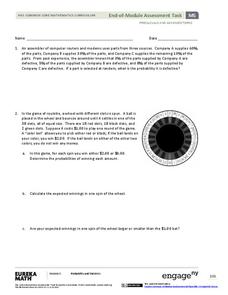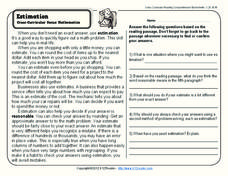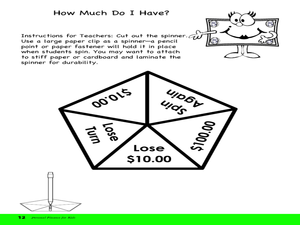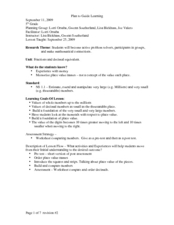EngageNY
End-of-Module Assessment Task - Precalculus (Module 5)
Give your young scholars a chance to show what they've learned from the module. The last installment of a 21-part series is an end-of-module assessment task. It covers basic and conditional probabilities, expected value, and...
Curated OER
Money Values Worksheet Lesson
Students determine how many dollars, quarters, nickels, dimes, and pennies equals a given dollar amount.
Curated OER
Money Pit
Sixth graders make a list of aspects of our culture found on a penny, and then observe another object based on another culture. In this culture lesson plan, 6th graders take their new object and research that culture.
Curated OER
Addition word problems
In this addition worksheet, learners complete addition word problems involving money, base ten blocks, and more. Students complete 10 addition word problems.
Curated OER
Grocery Shopping Trip - Coin Values
In this coin value matching worksheet, students cut out pictures of coins that show the monetary amounts on them. They place the coins on the worksheet to show what is needed to pay for each grocery item.
Curated OER
Math Games for Skills and Concepts
A 27-page packet full of math games and activities builds on algebra, measurement, geometry, fractional, and graphing skills. Young mathematicians participate in math games collaboratively, promoting teamwork and skills practice.
Los Angeles County Office of Education
Assessment for the California Mathematics Standards Grade 1
Here is an assessment designed to test mathematicians' knowledge of writing numbers, comparing numbers, skip counting, solving addition and subtraction problems; along with measuring objects, telling time, identifying shapes, reading...
K12 Reader
Estimation
When is it a good idea to use estimation? Learn about estimation and rounding with a reading comprehension lesson. After kids read a passage about estimation, they answer five comprehension questions on the other side of the page.
Curated OER
Your Food Dollar (and Cents)
Students examine where their food dollars go while recognizing coins and making change. They identify their favorite foods, receive one dollar, and take away amounts for each person involved in the production of their food dollar.
Curated OER
Grocery Shopping Trip 2- Coin Values
In this coin value worksheet, students cut out coins that are labeled with money amounts. They place the coins in the circles next to the pictures of grocery items. They make the coin values add up to the price that is given for the item.
Scholastic
Study Jams! Addition & Subtraction of Decimals
So current with preteens is the topic of downloading tunes into their computers! In a relatable lesson, viewers are taught to figure out if Zoe can afford to purchase two songs if she has $3.00 left to her credit. Mia talks them through...
Alabama Learning Exchange
Pizza! Pizza! Pizza!
Fifth graders practice using money in everyday situations. They use their addition and subtraction skills as they work in cooperative groups to solve problems involving decimals.
Curated OER
Wealth
Third graders read the story The Day I Was Rich and learn about the role of money and taxes. For this money lesson plan, 3rd graders count large sums of money, group them, and give it away in the form of taxes. They discuss wealth and...
Curated OER
In the Bag!
Students calculate how many quarters are in a $1,000 bag (after learning the dollar value of filled coin bags). They explain their problem-solving strategy using pictures, numbers, equations, and/or words.
Curated OER
Fractions and Decimal Equivalents: Fifth Grade
Sometimes a skeleton is all you get. This lesson outline provides teachers with a basic lesson flow. Pupils will pre-test, order place value names, use manipulatives, and build and compare numbers. How this is to be done is not...
Curriculum Corner
Fifth Grade Summer Math Booklet
A 33-page packet focuses on fifth-grade math concepts. Learners practice rounding numbers to the hundred thousands, thousands, hundreds, tens, ones, hundredths, thousandths, and hundred thousandths. They also compare whole...
Institute for Energy and Environmental Research
Practice with Scientific Notation
Zeroes are more important than they look! A guided practice activity takes learners through the process of both scientific and decimal notation, culminating in more complex word problems and equations.
Curated OER
Nickel
In this math worksheet, students place pennies in a box to show the amount each pictured toy would cost. When five pennies are used, students trade them for one nickel.
Curated OER
Get Ready, Get Set, Squeeze!
Pupils explore coin value and count coin combinations. For this money counting and social studies lesson, students read The Coin Counting Book by Rozanne Lanczak Williams and practice counting money and making change for a lemonade stand...
Curated OER
Comparing Amounts
In this mathematics worksheet, 1st graders identify who has more money. Then they write how much each person has and circle the one with more money. Students also place a group of coins on their desk and write down how much they have.
Curated OER
Sides of a Texas Quarter
Young scholars study the meaning, symbolism, and value of U.S. coins, especially the quarter. They research Texas symbols online and create a design for the obverse and reverse sides a Texas quarter in a choice of media.
Curated OER
Two of Everything
Learners listen to story Two of Everything, illustrate coins they would put into the Magic Pot using paper and pencil, and solve Magic Pot riddles by viewing slide show and predicting coin totals. Students then create table listing...
Curated OER
Decimal Notation for Pennies and Dimes
Second graders write money in decimal form. In this money lesson, 2nd graders discuss the value of coins and find the placement of the decimal in writing the amount. They find the fractional parts of coins in a dollar.
Curated OER
Compounding with 100% Interest Rates
Your young economists will be amazed at the effect of compounding interest more frequently in this collaborative task about making sound financial choices. Learners are walked through the calculations of a couple of examples and then...

























